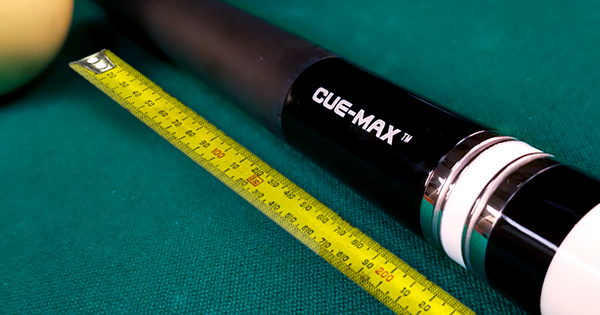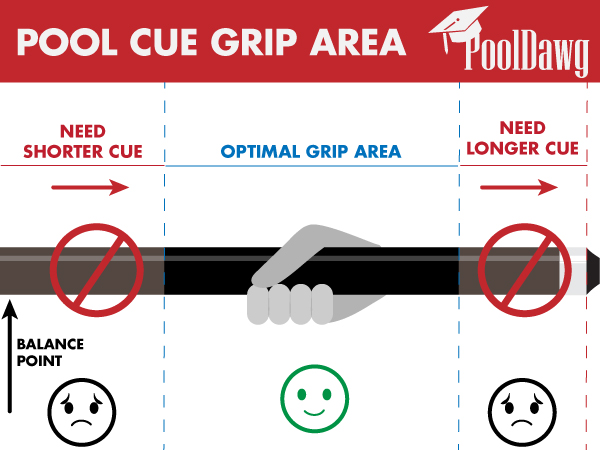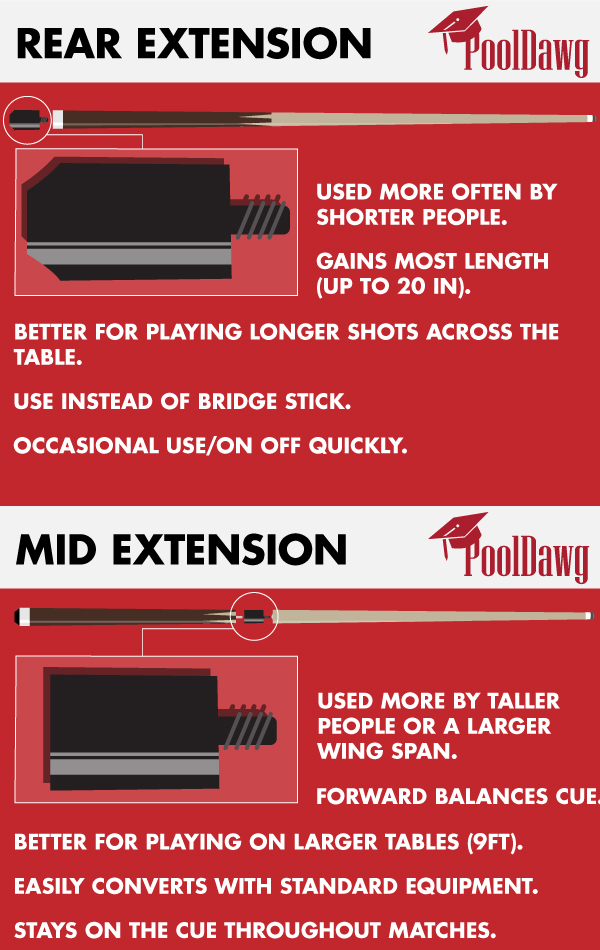
Q: “Do you think it is beneficial for taller players to get longer sticks? If someone is 6’2” or taller should they try to get a longer shaft, custom built cue or one of the middle cue extensions?”
A: As with most pool issues, there are pros & cons. Working with players of all sizes, I've come to the general opinion that players about 6'4" and taller really need a longer cue. Also, players with very long arms, very broad shoulders, or a very long bridge sometimes also qualify. And some short players play with a longer cue so they can reach more shots without the mechanical bridge.
My opinion comes from a purely mechanical analysis of players' setups. We strive to arrange players' bodies around the pool cue in the most efficient way, allowing them to stroke straight without having to steer around their bodies. Our simple setup calls for the player to grip the cue such that, when the tip is at the cue ball, their forearm is perpendicular to the stick (90 degrees). The longer their bridge is, the farther back this places the grip hand. In addition, some players arrange their shoulders fairly square to the shot line, while others align their shoulders more toward parallel to the shot line. Square shoulders bring the grip more forward, while "longer" shoulders move the grip back.
If you find yourself often gripping the bumper at the bottom of your cue, you may need a slightly longer stick. Our cues have been developed to perform really well at our standard length. Many cue makers will only offer a 1/2" or 1" longer shaft as a way to make the cue longer without losing its playability. Some cue makers will also make a slightly longer butt, as needed. (Be aware not all cue cases will fit non-standard cues, so you may have to buy a new case.)

As cues get longer, the balance point moves toward the butt and the stick gets heavier. Both of these factors are vital to a player's feel. You generally want to grip behind the balance point so the front of your stick is happy to stay down in your bridge hand (with an open bridge). A change in balance point of even a 1/2" changes how the stick feels. So, to make longer cues that perform well is a challenge for cue makers.
My advice is, if you're going longer, try just adding a few inches. Anything more than 6" is probably going to be too much. Up until somewhere in the 1960's, pool cues were 57". But overall, players were shorter back then. Standard length evolved to 58" and cue makers went to work on making them perform well. 58" is still the standard today, but we have lots of tall players now.
 Frank Says: "If you are looking for a little extra reach at the table, try out a mid-cue extension like the X5 Extension or the Balance Rite. Available in multiple pin sizes, these extensions are perfect for adding a few inches to your favorite cue.”
Frank Says: "If you are looking for a little extra reach at the table, try out a mid-cue extension like the X5 Extension or the Balance Rite. Available in multiple pin sizes, these extensions are perfect for adding a few inches to your favorite cue.”
Yes, Earl Strickland and ShaneVan Boening (super pros) both now play with extremely long cues that have been custom made for them. They are both tall players and they sometimes play on 10' tables. Their cues are 8"-12" longer than standard. But that doesn't mean we all should run out and get monster long cues. As we say in pool school all the time, "Don't imitate the pros. They can do what they do, and do it perfectly, because stroking that cue is their full-time job. Instead, let's develop the simplest, most reliable setup and stroke form we can."
If you're frequently running out of stick to grip, you may need to shorten your bridge. If bridge length is not an issue, you may need a longer cue. But if you just need some extra length to help you reach more shots, we now have lots of different cue extensions that can temporarily make your stick longer. Some cue makers offer a lightweight extension that screws into the bumper, and some manufacturers offer an extension that goes in-between the shaft & butt. When you use one of these products, your stick will feel & behave differently.

Practice up.
- Tom Simpson